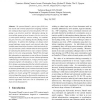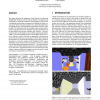1993 search results - page 50 / 399 » Designing and Building Parallel Program |
IPPS
1999
IEEE
14 years 3 days ago
1999
IEEE
A structured approach to parallel programming allows to construct applications by composing skeletons, i.e., recurring patterns of task- and data-parallelism. First academic and co...
ASPDAC
2006
ACM
14 years 1 months ago
2006
ACM
Recent research results have seen the application of parallelizing techniques to high-level synthesis. In particular, the effect of speculative code transformations on mixed contr...
HPDC
2003
IEEE
14 years 1 months ago
2003
IEEE
Abstract. We present PlanetP, a peer-to-peer (P2P) content search and retrieval infrastructure targeting communities wishing to share large sets of text documents. P2P computing is...
SIGGRAPH
1997
ACM
14 years 4 hour ago
1997
ACM
This paper describes the integration of the Berkeley Architectural Walkthrough Program with the National Institute of Standards and Technology’s CFAST fire simulator. The integ...
POPL
1989
ACM
13 years 12 months ago
1989
ACM
raction that a programming language provides influences the structure and algorithmic complexity of the resulting programs: just imagine creating an artificial intelligence engine ...


